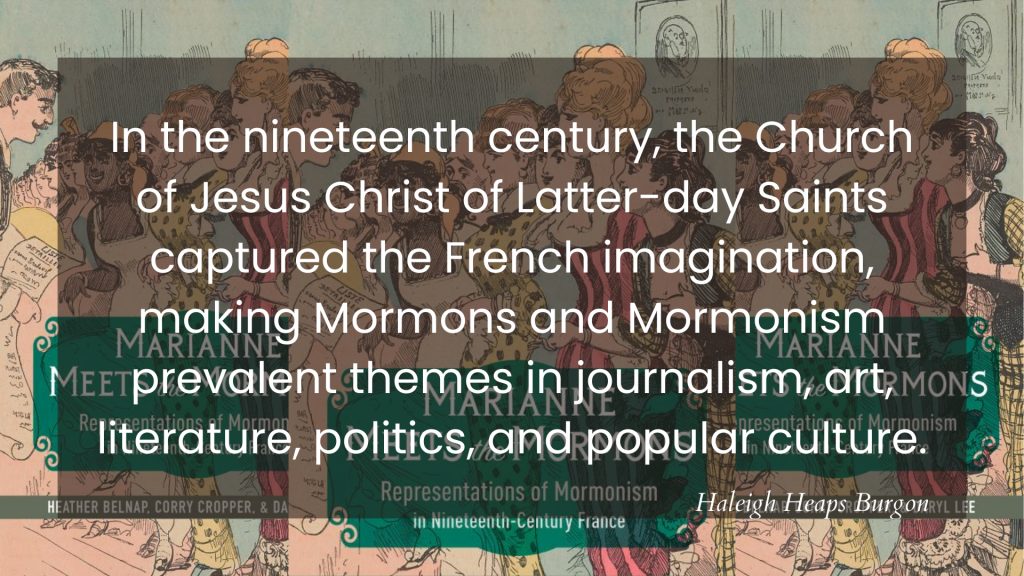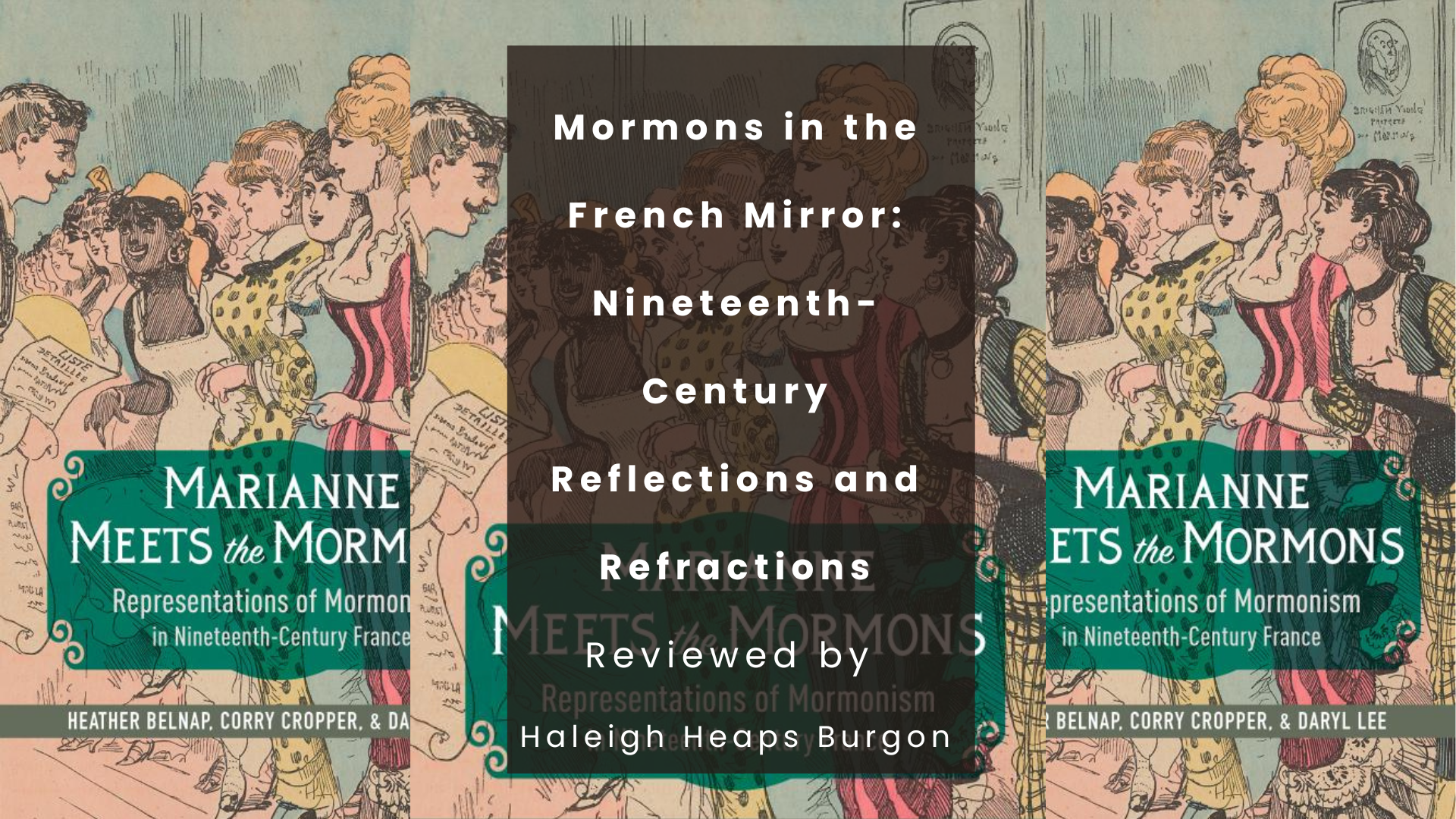Articles/Essays – Volume 58, No. 3
Mormons in the French Mirror: Nineteenth-Century Reflections and Refractions | Heather Belnap, Corry Cropper, and Daryl Lee, Marianne Meets the Mormons: Representations of Mormonism in Nineteenth-Century France
In the nineteenth century, the Church of Jesus Christ of Latter-day Saints captured the French imagination, making Mormons and Mormonism prevalent themes in journalism, art, literature, politics, and popular culture. In Marianne Meets the Mormons: Representations of Mormonism in Nineteenth-Century France, Heather Belnap, Corry Cropper, and Daryl Lee illuminate French portrayals of Mormonism from the 1830s to 1914, showing how these depictions often served as critiques and parodies of French society. Mormonism became a lens through which the French reexamined such issues as gender, colonialism, marriage and family, and church-state relations, offering artists and writers a vehicle for exploring the complexities of their own evolving national identity.
Belnap, Cropper, and Lee all teach at Brigham Young University in the fields of literature and visual culture. The result of this collaboration is a meticulously researched, cohesive, and both visually and intellectually engaging narrative of how the French used Mormonism to work out their own cultural preoccupations. The text is both a critical academic resource and a fascinating narrative that will appeal to both LDS Church members and nonmembers alike. Furthermore, the authors address the topic with sensitivity, unlike previous works that tend to exoticize and treat Mormons and Mormonism as an Other in much the same way that the French imagination did in the nineteenth century.
As the book opens, a chronology of key publications and events proves very helpful to understand how Mormonism is situated within French history during the Second Empire. The book contains eight chapters, and its approach is impressively interdisciplinary. The authors skillfully weave together historical analysis, cultural studies and religious studies to address French anxieties concerning marriage, gender, colonialism, and more. The chapters succeed at dialoguing with each other in a seamless manner.
In the engaging first chapter, the authors make a fascinating connection between a provocative political cartoon (in which Victor Hugo is offered Mormon polygamist wives on a silver platter) and the book’s premise—that throughout the nineteenth century, Mormonism was used in France to expose, mirror, and parody contemporary French issues. In this instance, the satire provoked questions of marriage, gender, and sexuality. Belnap, Cropper, and Lee show how the French fascination with and interpretation of Mormonism reveals volumes when considered within its social context.

Throughout the book, Belnap, Cropper, and Lee support their claims with newspapers from across a diverse political spectrum. Yet, while the French referenced early Mormon prophets like Joseph Smith and Brigham Young, the authors are clear from the beginning that the French were preoccupied with the idea of Mormonism rather than the actual religion. They used the concept of Mormonism as a means to understand their own changing social norms, often by exaggerating what little they did know about Mormonism. Chapter 2 explores in depth instances where Mormons were equated with other French socialist groups in order to vilify any ideas that may have a potentially damaging effect on society.
In chapter 3, the authors delve into what they describe as “the Woman Question” in France in relationship to the French fixations on gender roles in the Mormon household. The many representations of Mormon women—including “naïve martyr, haremic femme fatale, overworked housewife, Amazonne, and emancipated nouvelle femme” revealed French anxieties as women of this era began to question and stray from traditional gender norms (57). A portrait of activist Olympe Audouard presents a compelling argument for the book’s thesis: An “alleged inciter of this Mormon mania in the capital of France,” she radically asserted that “in comparison to the French practice of taking multiple mistresses, the Mormon mode was more transparent and honorable” as wives and children were offered legitimacy and protection (55). Her self-critical writings stirred discomfort within French readership, and they continued to deflect the criticism back toward the curious Mormons.
The third chapter is one of the strongest, as the authors’ argument is brought to life through numerous illustrations from the press by Albert Robida and Honoré Daumier, along with several relevant paintings and popular images circulating at the time. These visual elements are not merely illustrative but are thoughtfully integrated into and analyzed in the text, providing additional context and enhancing the reader’s understanding of nineteenth-century masculine anxieties. The careful translations of the captions enable non-francophone readers to understand the satirical tones conveyed through the images. In addition to its scholarly contributions, carefully chosen images throughout the entire book render it engaging and accessible. Finally, the treatment of gender in chapter 3 lays the groundwork for further exploration of marriage and divorce in chapter 6.
Another powerful moment in the book occurs in chapter 7, which situates Mormons within the French colonial project. Belnap, Cropper, and Lee detail the exoticized representations of both Mormon men and women, which mirrored the well-established orientalist models from the Second Empire and Third Republic. Robida and others’ images of orientalized Mormon men leading their harems of polygamist wives were rampant. The authors provide close analysis of popular vaudeville plays on the topic, most notably Les Douze femmes de Japhet (1890)—a Montesquieu-esque parody of the French colonial system. Despite this, the authors note that while the French mock unconventional religious and social practices, we do not witness the same “otherness” present in the stereotypically violent or hypersexualized portraits of North Africa and the Middle East that were in vogue at the time. Unlike those “others,” the French saw a part of themselves in the Mormon agenda, as they carried out their mission civilisatrice and intended to bring enlightenment to the whole morally decaying earth.
In conclusion, Marianne Meets the Mormons is a groundbreaking work that makes significant contributions to our understanding of the French’s imagined representations of Mormonism. Belnap, Cropper, and Lee term this book a work of “decolonization” as it contrasts with the Americentric scholarship often associated with LDS historical writing and responds to the need for a more “translocative history of Mormonism” (241). The authors have produced a diligently researched and compelling narrative that is both academically rigorous and accessible to a wide audience. Furthermore, while this book is highly erudite and provides continual in-depth analyses, it succeeds at also integrating a sense of humor with regard to the curiosities that it presents. This book will be an essential resource for scholars of nineteenth-century France and Mormon history and a fascinating read for anyone interested in the intersections of culture, religion, and history. Marianne Meets the Mormons is a testament to the power of collaborative scholarship and a valuable addition to the field.
Heather Belnap, Corry Cropper, and Daryl Lee. Marianne Meets the Mormons: Representations of Mormonism in Nineteenth-Century France. Urbana: University of Illinois Press, 2022. 304 pp. Paperback: $30.00. ISBN: 978-0-252-08676-2.


 Back to full Issue
Back to full Issue

